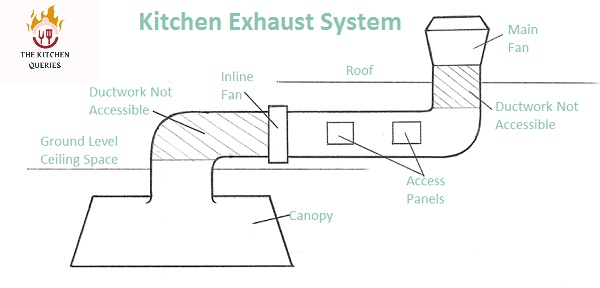A kitchen exhaust system is designed to remove smoke, heat, grease, and odors generated by cooking appliances such as stovetops, ovens, and grills.
The primary function of a kitchen exhaust system is to improve the indoor air quality of the kitchen area by removing airborne contaminants.
A typical kitchen exhaust system comprises a hood, ductwork, an exhaust fan, and an optional filtration system. [Working of each component explained below]
Kitchen exhaust systems may be designed for either vertical or horizontal exhaust.
A vertical exhaust system vents the contaminated air directly through the roof. In contrast, using a horizontal duct, a horizontal system vents the air through a wall or roof.
Proper installation, maintenance, and cleaning of a kitchen exhaust system are critical for ensuring its effectiveness and safety.
Regular cleaning of the hood and ductwork is necessary to prevent the accumulation of grease and other contaminants, which can reduce the system’s efficiency and increase the risk of fire.

1. Hood:
The hood is the visible component situated above the cooking appliances.
It captures and contains the cooking vapors, grease, and particles produced during the cooking process.
Hoods come in various designs, such as wall-mounted, island, and under-cabinet hoods, each catering to specific kitchen layouts.
2. Filters:
Filters are installed within the hood to trap grease and other particulate matter before the air passes through the ventilation system.
These filters help prevent the accumulation of grease in ducts and fans, reducing the risk of fire hazards.
Mesh filters and baffle filters are common types used in kitchen exhaust systems.
3. Ductwork:
The ductwork is a network of pipes that transports the captured air from the hood to the outside of the building.
It is essential for the ductwork to be properly sized and sealed to ensure efficient airflow and prevent leaks.
Ducts can be made of various materials, including stainless steel and galvanized steel.
4. Exhaust Fan:
The exhaust fan is responsible for creating the necessary airflow to move the contaminated air through the ductwork and expel it outside.
The fan’s capacity must match the size and demands of the kitchen to ensure effective ventilation.
Variable speed controls may be incorporated to adjust the airflow as needed.
5. Make-up Air Unit:
In some systems, a make-up air unit is installed to replace the exhausted air with fresh outdoor air.
This prevents negative air pressure within the kitchen, which could impede the performance of the exhaust system.
Make-up air units contribute to a balanced ventilation system and enhance overall efficiency.

6. Fire Suppression System:
In commercial kitchens, fire suppression systems are often integrated into the exhaust system.
These systems automatically release fire-extinguishing agents in the event of a fire, providing an additional layer of safety.
7. Control Panel:
The control panel serves as the command center for the kitchen exhaust system.
It allows users to monitor and regulate the system’s performance, including adjusting fan speed, activating fire suppression systems, and ensuring proper filtration.
8. Access Panels and Cleanout Doors:
Regular maintenance is crucial for the effective operation of a kitchen exhaust system.
Access panels and cleanout doors provide technicians with easy entry points for cleaning and maintenance tasks, such as removing accumulated grease from filters and ductwork.
Video Guide:
Conclusion:
Understanding the components of a kitchen exhaust system is essential for ensuring a safe and efficient kitchen environment.
Regular maintenance and adherence to safety standards are key to preventing hazards, improving air quality, and prolonging the lifespan of the system.
Whether in a home kitchen or a commercial establishment, a well-designed and properly maintained exhaust system is critical for the well-being of both occupants and the structure itself.

I am a happy person. An adventurer. Currently wokring on different projects regarding SEO

